
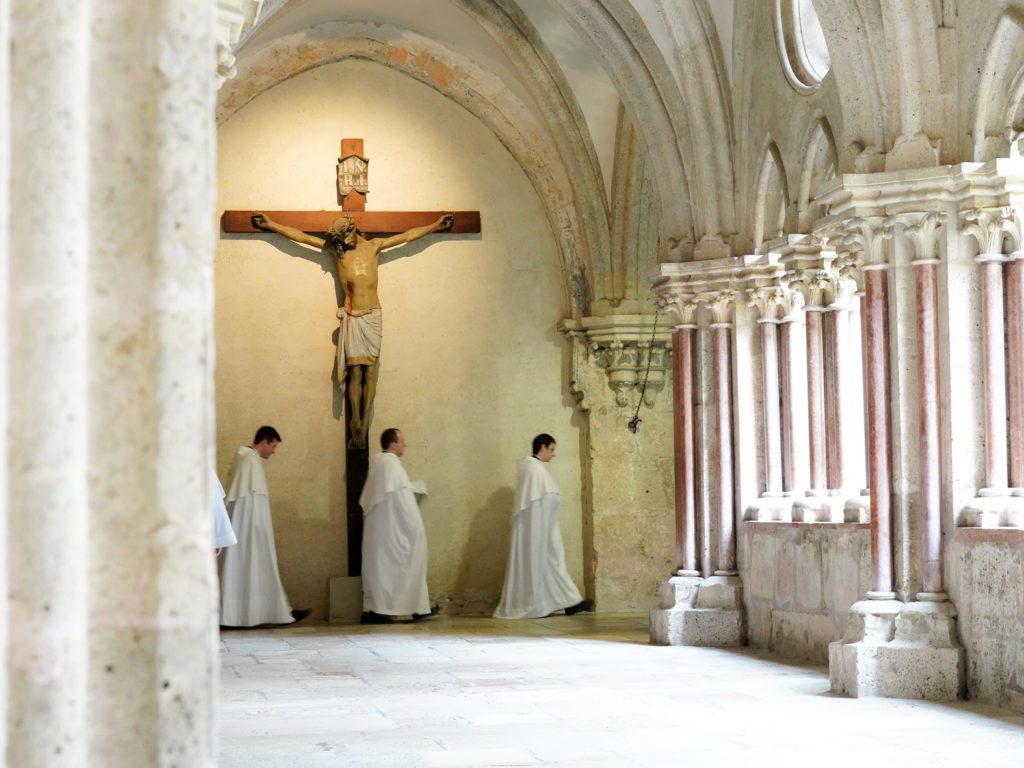
Monks in the cloister
„Stift Heiligenkreuz“, which means the „Abbey of Heiligenkreuz“, is a beautiful and living Cistercian monastery, close to Vienna, the capital of Austria. Stift Heiligenkreuz is the second-oldest Cistercian monastery in the world and the oldest continuously active and inhabited one, now full of young vocations. In September 2007 it was blessed by an official visit by Pope Benedict XVI.
Stift Heiligenkreuz, peacefully situated in the middle of the „Wienerwald“, the Vienna woods, is one of the most beautiful medieval monasteries in the world. It was founded in 1133 by St. Leopold III of the House of Babenberg. Leopold’s son, Otto, had been sent to Paris for an international education. Otto came in contact with Cistercian monks and soon decided to enter a Cistercian monastery. When Otto visited his father in Austria he asked him to build a similar monastery for Lower Austria. This was the reason St. Leopold built Heiligenkreuz as well as Klosterneuburg to the northwest of Vienna.
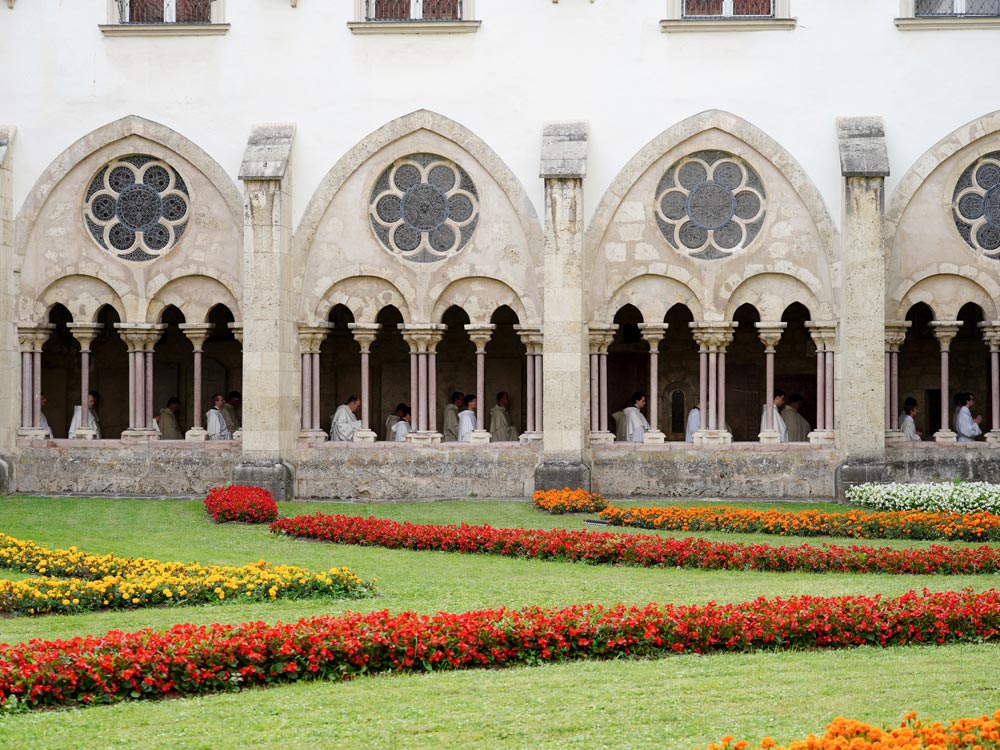
The garden in the cloister
Those seeking prayer and silence should go to the Holy Cross Chapel (Kreuzkirche).
(Available in 7 languages: German, English, French, Spanish, Italian, Hungarian and Russian)
Monday – Saturday:
9:00 a.m. – 11:30 a.m. (last entry 10:30 a.m.)
2:00 p.m. – 5:15 p.m. (last entry 16:30 p.m.)
Sundays and Feastdays:
2:00 p.m. – 5:15 p.m. (last entry 4:30 p.m.)
9.00 a.m. – 11:45 a.m.
1.30 a.m. – 5.15 p.m.
Winter: only till 4.00 p.m..
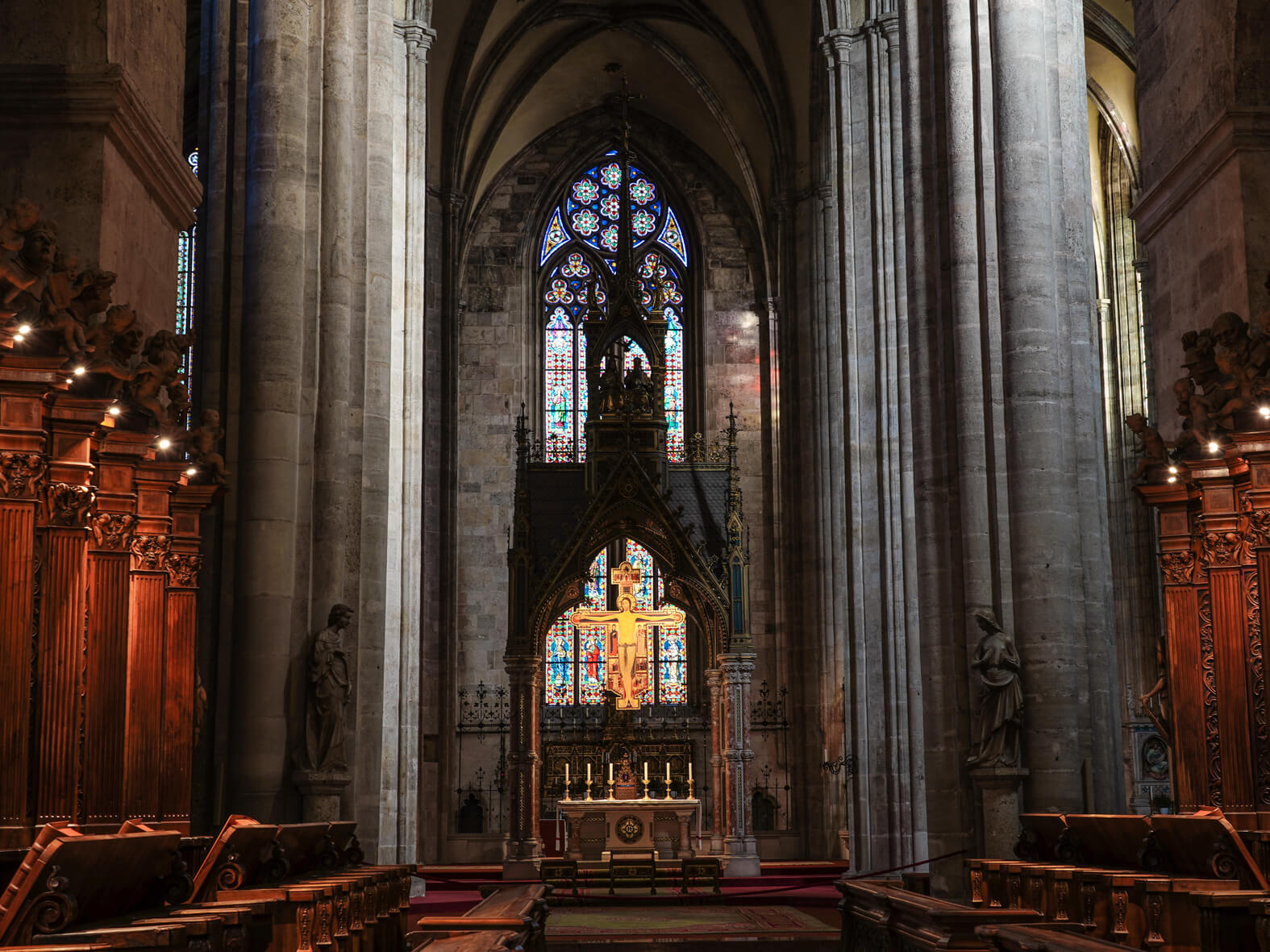
The interior of the abbey church
Romanesque nave (vaulted construction) of the collegiate church (consecrated 1187) preserved; Romanesque façade, crosssept (from the 13th century with earliest ribbed vault, with massive intersecting ribs, in Austria), impressive hall choir (consecrated 1295, a masterpiece of Austrian Gothic), cloister (1220-1240); re-gothicised in the 19th century; neo-gothic high altar (1887), Baroque altar painting by J. M. Rottmayr (1696), choir stalls (1707) by Giovanni Giuliani; nonagonal fountain-house with glass paintings of members of the Babenberg family (1290) and lead fountain from the 16th century.
In the late-Romanesque chapter room, tombs of 4 ruling dukes of the Babenbergs: Leopold IV, Leopold V, Friedrich I and Friedrich II; early-gothic dormitory; for English people it may be interesting, that Leopold V. was the „kidnapper“ of King Richard Lionheart. The tomb of Duke Leopold V. is in the Chapter House.
Baroque construction phase of the monastery from 1641, finished in 1662. Rebuilt after damage in 1683. In the early-Baroque courtyard: Trinity column (1736-39) and fountain of Saint Joseph by Giuliani (1739). Way of the Cross (1731-50) off the monastery grounds.
Zisterzienserabtei Stift Heiligenkreuz
2532 Heiligenkreuz im Wienerwald
+43-2258-8703-0
information@stift-heiligenkreuz.at
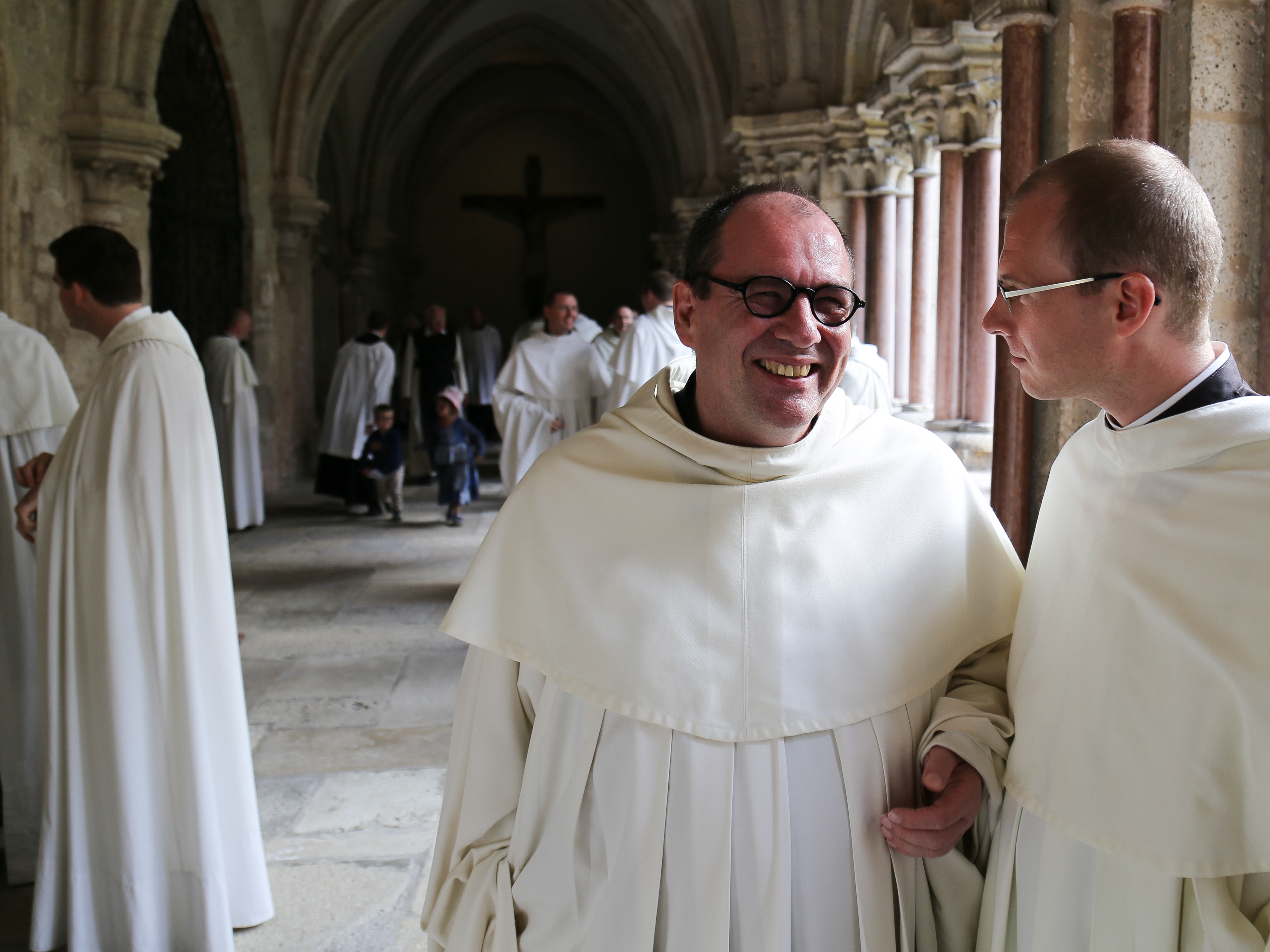
This Cistercian Abbey was founded in 1133 by Saint Leopold III as a house of prayer to thank and praise God and to intercede for the sake of the whole world. The spiritual and cultural life of this house has continued without any interruption or destruction. We Cistercians live in the rhythm of “ora et labora – pray and work”. Welcome to this holy place!
These days we monks sing the Divine Office in Gregorian Chant five times a day.
Prayers begin here at 5:15 a.m. and end at 8:00 p.m.
5.15 Vigil
6.00 Lauds
6.25 Conventual Mass (weekdays)
9.30 Solemn Mass with Gregorian chant (Sundays and Feast days)
12.00 Terz and Sext
12.55 None
18.00 Vespers
19.50 Compline with Salve Regina
afterwards adoration and rosary
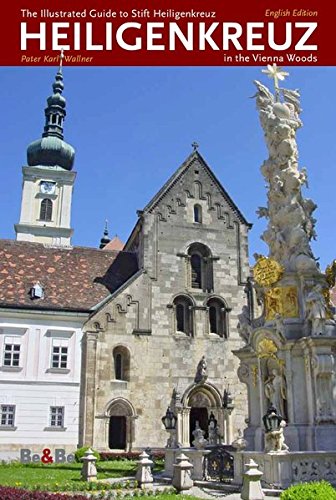
Autor: Pater Karl Wallner
Translation: Pater Alcuin Schachenmayr
168 pages / 24cm * 16cm
Be&Be-Verlag
Heiligenkreuz 2012
ISBN 978-3-902694-31-7
The abbey Stift Heiligenkreuz in the Vienna Woods is known far beyond our local borders. Heiligenkreuz was founded in 1133 by Leopold III, a member of the Babenberg dynasty and a saint. It has been a living monastery ever since. Stift Heiligenkreuz is only 15 kilometres from the edge of Vienna and easily reachable via highway A21. Despite the proximity to cosmopolitan Vienna, the monastery lies in a peaceful and secluded valley in the Vienna Woods, surrounded by gently rolling hills and forests of beech and fir.
The monks welcome visitors and guests, and the more than 100,000 tourists who visit the abbey every year! Here you can see all the major architectural styles and artistic movements of the last 900 years. You can visit the grave of the man who kidnapped Richard the Lionheart. And you can breathe in the incense-scented air in the light-drenched abbey church and marvel at the dancing skeletons in the Chapel of the Dead.
But most of all, Heiligenkreuz is no dusty museum: it is a living and vibrant monastery. Monks live and work here, and we pray the Divine Office every day for the people of the 21st Century. That means that you can hear the monks singing Gregorian chant here, you can attend Mass, you can pray and you can make confession. As it says on our website www.stift-heiligenkreuz.at: Stift Heiligenkreuz is the mystical heart of the Vienna Woods, a harmony of nature and culture, a union of the medieval and the baroque, a symphony of history and spirituality. This guide is writen by an monk. It is an invitation to you: Come and see!
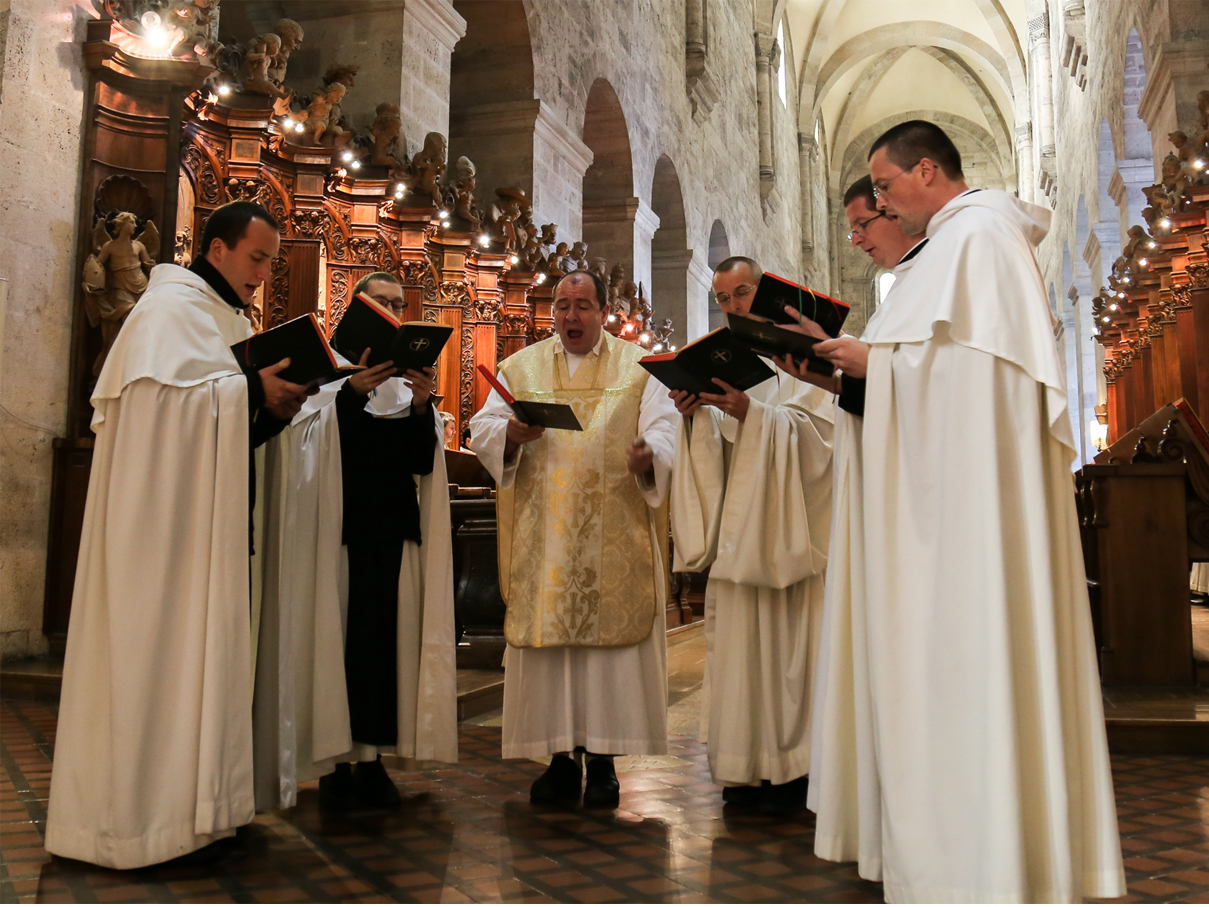
We Cistercians in Heiligenkreuz see the Liturgy, the solemn worship of God in his Holy Church, as our chief mission. The Rule of St. Benedict, by which we live, gives us a vision of the monastic life formed by two main elements „ora et labora” (pray and work); the monastic life is a life of common prayer and common work. But of these two the first, prayer, is the most important, „nothing is to be preferred to the Divine Office“ (Rule of St. Benedict, 43). In Heiligenkreuz the ancient liturgical prayers of the Church are still sung in the ancient liturgical music of the western Church: Gregorian Chant.
Thus we do not sing merely for artistic reasons, but our song is our form of prayer, meditation praise. That is why we all have to study Latin; so that we can attend to the meaning of the words that we sing. As the Liturgy is always a prayer of the Church, the faithful are always invited to join us—and many do.
The main part of our common prayer, which we monks begin at 5:15 every morning, consists in the solemn and meditative singing of the Psalms. Gregorian Chant is thus a kind of Bible meditation—almost all of the chanted texts are taken from the Bible.
Unlike the hymns common in modern churches, Gregorian Chants are not typically composed in stanzas, with the same melody repeated in each stanza, but rather each text has its own melody composed to bring out its meaning. Unlike much modern music, Gregorian Chant is always sung without accompaniment, and in unison; that is, there is only one melodic line, without harmony. This gives the Chant its austere sound, and the name „plainchant.“ This also however, allows the chant to be free of the rhythmical restraints necessary to keep several melodic lines together. Instead of being composed in strict rhythmic measures, the chant is composed in a free musical rhythm that rises and falls in accord with the inner meaning of the melody and words. Moreover, instead of being composed in major or minor key, like modern music, Gregorian chant is composed in eight „modes“—key like tonal structures—that allow for a wide range of musical moods.
The melodies go back to the earliest days of the church, and have there ultimate roots in the Jewish Temple Liturgy. The name „Gregorian Chant“ come form Pope Gregory the Great (died 604), who founded a chant schola in Rome that collected all the best chants. The Cistercians, as a reform order of the 12th century, simplified the chants somewhat to develop their one form of chant, which is slightly different from Roman Chant.
Gregorian Chant is always sung in Latin, and therefore it was threatened with extinction in the 1970s and 80s, when most Catholic Churches adopted modern language Liturgy. But today we are experiencing a remarkable renaissance of this ancient form of prayer—even young people nowadays are discovering the excitement of these melodies which have been sung through so many centuries. Of course, it must be said that it takes some time to listen oneself into this world of music, and develop an ear for its greatest treasures.